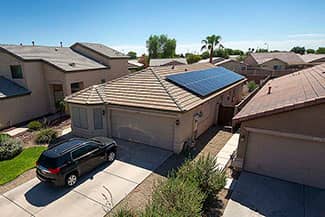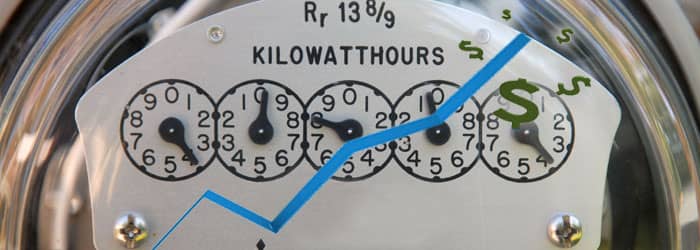EIGHT THINGS TO REMEMBER ABOUT INCREASES IN ELECTRIC RATES
The three major utilities in Arizona – APS, TEP and SRP – have all had rate increases in the past few years. When they announce increases, they often say things like “it’s only a $6-a-month increase” or “it’s a 4.5 percent increase for residential customers.”
It always sounds modest enough, but later your personal increases end up being more than those estimates.

For example, I recently calculated (on the APS Web site) that the increase will drive up my bill 41 percent annually if I stayed on a plan resembling my old plan. Even switching to another plan, it would go up 36 percent. However, we might not really know the full effect of the rate increases until a year from now.
So, how can you work with the new system? What rate plan should you choose?
If you have a large home or big family, you may even be interested in adding solar power to your house; maybe you might want a demand management computer as well. Now is the time to research those alternatives. Some experts have suggested that solar is bound to win new customers due to the rate changes.
Here are ideas to think about:
1 | Cooling power
Despite rate increases, we’re thankful for the electricity and air conditioning that cools our homes in July and August. Living in Arizona would be very difficult without cooling power.
2 | Closely analyze the new rate plans from APS
As you know, APS customers are in a transition period and have until May 1st to pick a new plan. Otherwise, the utility will assign you to a plan. But before making a choice, do as I did and find a paper or electronic copy of your latest bill; then go to the Internet and search for “APS service plan compare.” On that page, click “plan comparison tool.” You may have to register your residence first. But once you call up your account, you can analyze the six plans available and see how – based on previous bills – your future bills may increase.
3 | Tips about the new plans
You are not “grandfathered” into a rate plan from the old system. Everyone must pick a new plan. If you previously had the noon to 7 plan, a popular choice in the past, the new Saver Choice seems like the best option.
Those in small homes who use a lot less energy than other APS customers probably have two choices: Lite Choice for homes under 600 kWh a month or less or Premier Choice for those using 999 kWh a month or less. Under these plans it doesn’t matter what time you use electricity. Rates are the same for every hour of use.

Two other plans offer larger off-peak savings: Saver Choice Plus and Saver Choice Max. But these plans also have punishing demand charges if you slip up and use too much electricity at the wrong time. The easiest way to avoid that is adding a demand computer to your electric panel. Otherwise you as a homeowner “become” the computer. You will run around constantly to turn off the dryer or oven or AC during peak cost hours – all because of that demand charge.
4 | How a demand charge or rate works
According to APS, Saver Choice Plus and Saver Choice Max are service plans with “basic service charges, total usage charges and a peak hour usage charge.” That peak hour use charge, also know as the demand rate, can be horridly expensive. APS will take the one hour of the month when your energy used is highest during the on-peak hours Monday-Friday. It uses that hour to calculate your entire monthly peak hour usage charge – even though your monthly average is very, very low.
5 | Stay on the transition rates for a while
Most likely, the transition rate that you were moved to on Aug. 19 is higher than what you had before. But the transition rates are generally less costly than new plans. So, take time in moving to your next plan. But don’t forget to choose a plan by May 1st.
6 | If you are on a monthly budget pay plan, cancel it
Under these plans, customers pay the same amount each month no matter how much electricity they use all year. But these plans make it much harder to figure out how to use less electricity.
7 | Super-cooling will be difficult to do now
Some years ago, we started telling homeowners about using super-cooling to cut down AC bills in summer. The idea was to dramatically super-cool your homes during the “cheaper” rate periods each day. Then when the expensive on-peak hours arrived, you would raise the thermostat to the warmest level you could stand in summer – maybe 78 or 79. By then, your house would be so cool; your air conditioner didn’t come back on for hours.
That particular method probably won’t work now because those “cheaper” off-peak rates won’t be as cheap any more. That means we’ll all have to experiment with our methods. It’s possible you can still reduce your summer cooling bills by 10 percent, but not the 30 to 50 percent you got before. After next summer, however, you will have a better idea about scheduling cooling in your home as cheaply as possible.
8 | Solar firms expect to increase their business

For many years, solar companies have told us that their panels are a good investment for handling situations like the new APS rates. They are also telling APS customers that they can achieve even greater savings by installing a demand management computer as well.
One last word, if you don’t like the rate plan you picked, APS will let you pick a new one but after that, you will have to wait an entire year before switching to something else.
For more information, check out the comparison of new summer rates that was put together by Advanced Home Systems of Phoenix. You can also look at the APS chart that compares resident rates for summer and winter in addition to the APS Rate Sheet that might not be so confusing.
###
Photo Credits:

















